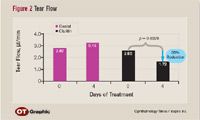Article
Topical allergy agents keep ocular surface safe
Commonly used systemic antihistamines taken for seasonal allergies can cause ocular surface drying that in turn aggravates ocular allergy symptoms. Antihistamine drops specifically formulated for ocular allergies, in contrast, do not appear to decrease tear volume or tear flow or cause ocular surface damage, according to several investigators who have studied ocular drying. However, in a separate mouse study, topical ocular allergy medications themselves may have different effects on tear volume or tear flow.

"We have studied topical ocular allergy agents in numerous studies with hundreds of patients, and we have not seen dry eye as a major side effect as you would with a systemic medication," said Paul Gomes, director, allergy department, ORA Clinical Research and Development, Andover, MA. "We're talking about less than a 1% incidence rate, which is comparable with what you would see in vehicle or placebo. As a whole, topical ocular antihistamines have no effect in terms of increased drying."

Systemic antihistamines have a negative effect through pharmacokinetics and bioavailability, Gomes continued. Because they are metabolized as they pass through the liver and into the bloodstream, they do not become concentrated in the conjunctival tissue as a topical ocular antihistamine would. Also, when a high concentration of antihistamines develops systemically, it produces an antimuscarinic effect at the lacrimal gland, decreasing tear production and inducing dry eye.
However, topical medication instilled onto the ocular surface that reaches the conjunctiva and the histamine receptors is more effective than a systemic antihistamine at controlling the symptoms of ocular allergies without causing ocular drying.
"We have shown that compared with a systemic or a nasal steroid, topical ocular therapy is superior," Gomes said. "In our clinic we have also seen the effect of systemic antihistamines in the decrease of tear volume, leading to dry eye. Systemic therapy will enhance the symptoms of ocular allergy in those patients and make them more susceptible to having ocular allergic reactions and will also increase the intensity of those reactions," Gomes said.
George Ousler, director of dry eye at ORA Clinical Research and Development, cited studies his group has conducted of systemic allergy medications such as cetirizine HCl (Zyrtec, Pfizer) and loratadine 10 mg (Claritin, Schering-Plough). "After just 4 days of use as prescribed, there is a significant increase in dry eye, and that means increased corneal and conjunctival staining, increased break-up time, and increased symptoms in allergic patients or normal subjects," he said.
In addition, fluorophotometry measurements have shown increased dryness and decreased volume or tear flow.
Newsletter
Don’t miss out—get Ophthalmology Times updates on the latest clinical advancements and expert interviews, straight to your inbox.





